

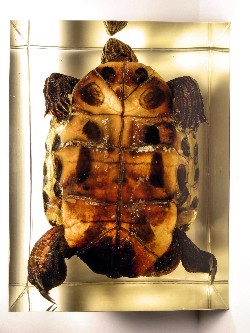




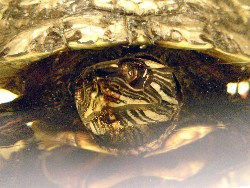

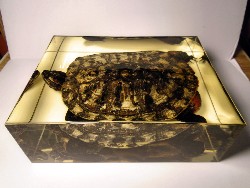


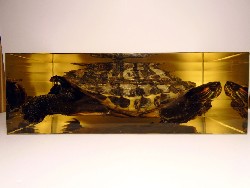
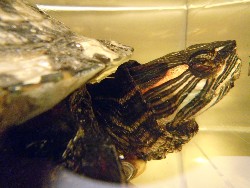
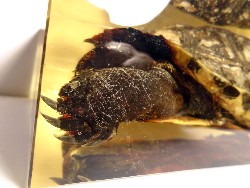


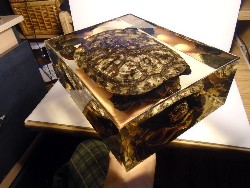


 |
 |
 |
 |
 |
 |
 |
 |
 |
 |
 |
 |
 |
 |
 |
 |
 |
 |
 |
 |
|
Red-Eared Slider Trachemys scripta elegans  CLICK FOR DOWNLOAD --------------------------------- Classification Phylum Chordata Class Reptilia Subclass Anapsida Order Testudines Family Emydidae Genus Trachemys Species Trachemys Scripta Subspecies Trachemys Scripta Elegans
.............................. Proper Care & Maintenance of Water Turtles
CLICK FOR DOWNLOAD |
TRACHEMYS SCRIPTA ELEGANS TURTLE The red-eared slider (Trachemys scripta elegans), also known as the red-eared terrapin, is a semiaquatic turtle belonging to the family Emydidae. Red-eared sliders get their name from the small red stripe around their ears.. The "slider" in their name comes from their ability to slide off rocks and logs and into the water quickly. The red-eared slider belongs to the order Testudines, which contains about 250 turtle species. It is a subspecies of Trachemys scripta. They were previously classified under the name Chrysemys scripta elegans. It is a subspecies of the pond slider. It is the most popular pet turtle in the United States and is also popular as a pet in the rest of the world. It has, therefore, become the most commonly traded turtle in the world. It is native to the southern United States and northern Mexico, but has become established in other places because of pet releases, and has become an invasive species in many areas, where it outcompetes native species. The red-eared slider is included in the list of the world's 100 most invasive species published by the IUCN. Description The carapace of this species can reach more than 40 cm in length, but the average length ranges from 15 to 20 cm. The females of the species are usually larger than the males. They typically live between 20 and 30 years, although some individuals have lived for more than 40 years. Their life expectancy is shorter when they are kept in captivity. The quality of their living environment has a strong influence on their lifespans and well being. These turtles are poikilotherms, meaning they are unable to regulate their body temperatures independently; they are completely dependent on the temperature of their environment. For this reason, they need to sunbathe frequently to warm themselves and maintain their body temperatures. The shell is divided into two sections: the upper or dorsal carapace, and the lower, ventral carapace or plastron. The upper carapace consists of the vertebral scutes, which form the central, elevated portion; pleural scutes that are located around the vertebral scutes; and then the marginal scutes around the edge of the carapace. The rear marginal scutes are notched. The scutes are bony keratinous elements. The plastron is highly variable in pattern. Turtles also have a complete skeletal system, with partially webbed feet that help them to swim and that can be withdrawn inside the carapace along with the head and tail. The red stripe on each side of the head distinguishes the red-eared slider from all other North American species and gives this species its name, as the stripe is located behind the eyes where their ears would be. These stripes may lose their color over time. Some individuals can also have a small mark of the same color on the top of their heads. The red-eared slider does not have a visible outer ear or an external auditory canal; instead, it relies on a middle ear entirely covered by a cartilaginous tympanic disc. Distribution and habitat The red-eared slider originated from the area around the Mississippi River and the Gulf of Mexico, in warm climates in the southeastern United States. Their native areas range from the southeast of Colorado to Virginia and Florida. In nature, they inhabit areas with a source of still, warm water, such as ponds, lakes, swamps, creeks, streams, or slow-flowing rivers. They live in areas of calm water where they are able to leave the water easily by climbing onto rocks or tree trunks so they can warm up in the sun. Individuals are often found sunbathing in a group or even on top of each other. They also require abundant aquatic plants, as these are the adults' main food, although they are omnivores. Owing to their popularity as pets, red-eared sliders have been released or escaped into the wild in many parts of the world. Hibernation Red Eared Sliders do not hibernate, but actually brumate; while they become less active, they do occasionally rise to the surface for food or air. Brumation can occur to varying degrees. In the wild, red-eared sliders brumate over the winter at the bottoms of ponds or shallow lakes. They generally become inactive in October, when temperatures fall below 10C (50 F). During this time, the turtles enter a state of sopor, during which they do not eat or defecate, they remain nearly motionless, and the frequency of their breathing falls. Individuals usually brumate underwater, but they have also been found under banks and rocks, and in hollow stumps. In warmer winter climates, they can become active and come to the surface for basking. When the temperature begins to drop again, however, they quickly return to a brumation state. Sliders generally come up for food in early March to as late as the end of April. During brumation, T. s. elegans can survive anaerobically for weeks, producing ATP from glycolysis. The turtle's metabolic rate drops dramatically, with heart rate and cardiac output dropping by 80% to minimise energy requirements. The lactic acid produced is buffered by minerals in the shell, preventing acidosis. Red-eared sliders kept captive indoors should not brumate.
|